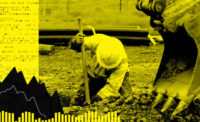The construction unemployment rate fell sharply in April, to 6.3% from March's 8.4%, but it rose slightly from the year-earlier 6%, the Labor Dept. has reported.
The department's Bureau of Labor Statistics (BLS) also said in its latest monthly employment report, released on May 5, that construction added 5,000 jobs during April.
April's unemployment rate marks the third month this year in which the industry's number was higher than the comparable 2016 figure.
Before January 2017, construction had posted more than 70 straight months of year-over-year improvements in its jobless rate.
BLS jobless rates aren't adjusted for seasonal variations; construction's rate tends to decline in the spring and summer months when the volume of building picks up.
The April jobs-added picture was mixed among construction sectors. The heavy and civil engineering segment, which includes infrastructure work, was the strongest, with a gain of 4,300 positions.
The non-residential buildings sector was up by 4,000; the residential specialty trade contractors' category saw its workforce expand by 3,600.
But non-residential specialty trade firms lost 5,100 jobs and the residential building sector shed 2,700.
Anirban Basu, Associated Builders and Contractors' chief economist, said in a statement that the drop in non-residential specialty trades' employment may be due to a beginning of a slowdown in some private-development sectors or just "a one-month statistical anomaly."
Construction contractor group officials noted that the industry's workforce grew by 2.6% over the previous 12 months, outpacing the overall U.S. economy's 1.6% employment increase.
The Associated General Contractors pointed out that construction's total workforce reached nearly 6.9 million in April, the highest total in more than nine years.
Stephen Sandherr, AGC's CEO, said in a statement that "many firms would likely have added even more workers if only they could find enough qualified people to bring on board."
More broadly, BLS reported that the U.S. economy added 211,000 jobs in April. The overall unemployment rate edged down to 4.4, from the March level of 4.5%. It also was better than the year-earlier 5%.



Post a comment to this article
Report Abusive Comment